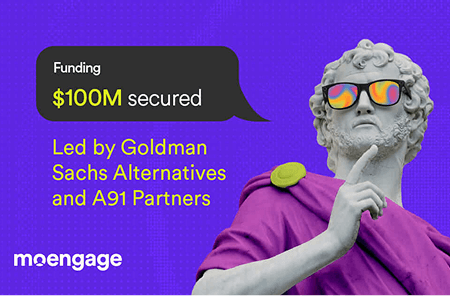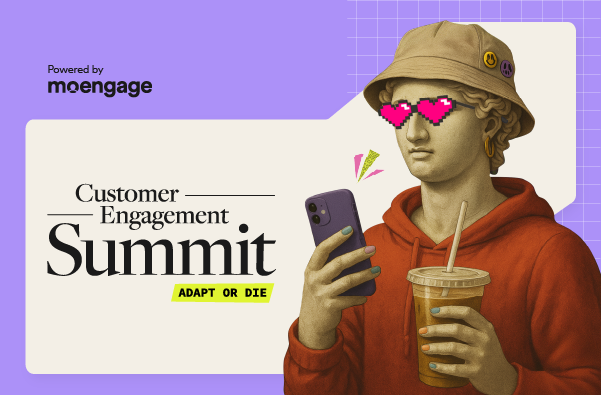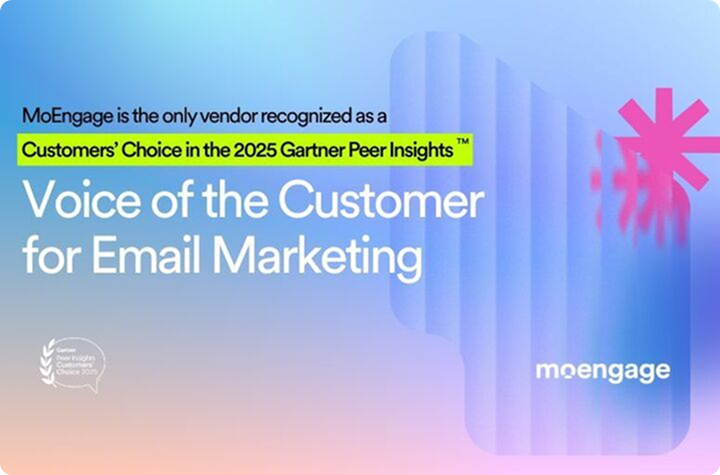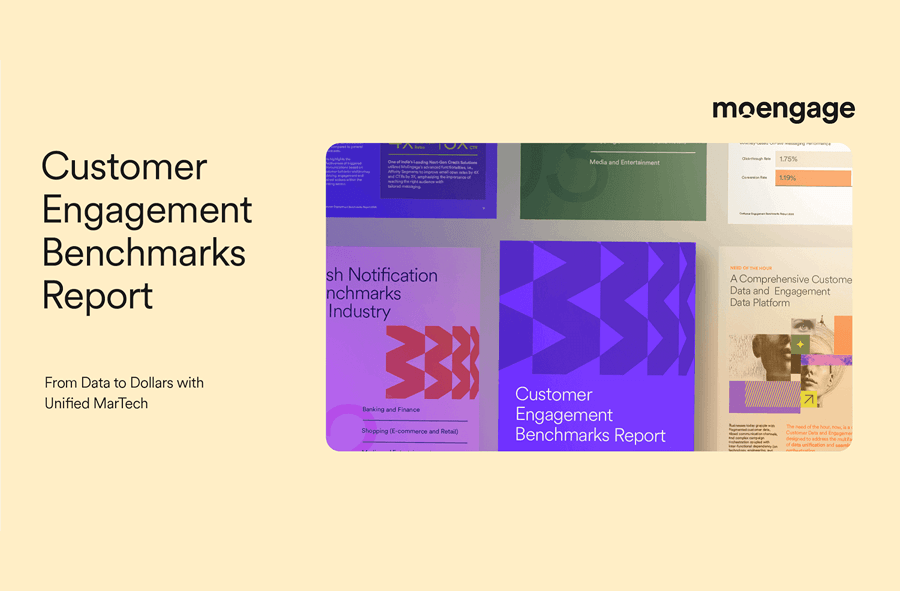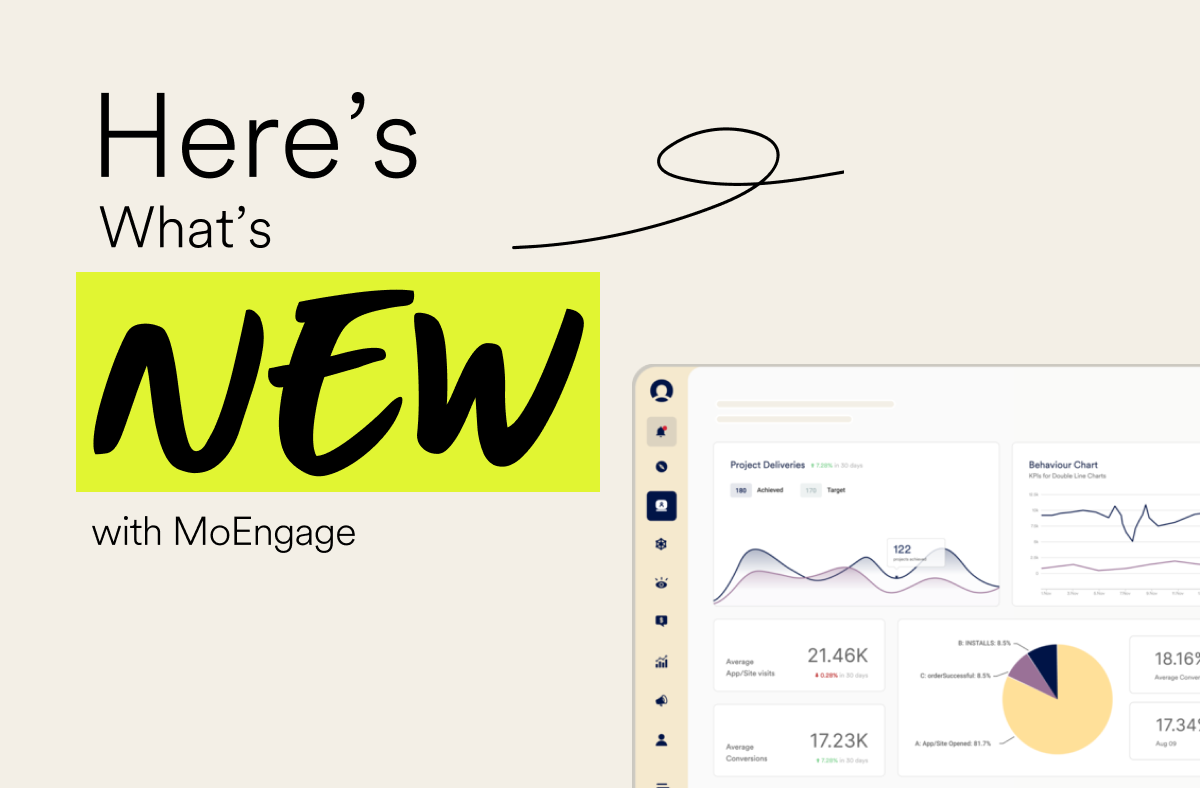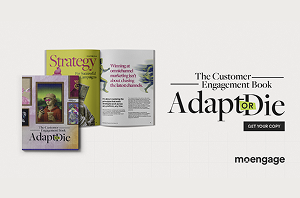9 Salesforce Marketing Cloud Competitors to Engage Customers

Reading Time: 18 minutes
Using a legacy customer engagement platform like Salesforce Marketing Cloud means certain trade-offs you can’t ignore. From complicated integrations and slower go-live timelines to a steeper-than-necessary learning curve, it’s not always the right fit for a B2C brand like yours. Is that why you’re searching for Salesforce Marketing Cloud competitors and alternatives?
Or maybe it’s because Salesforce’s frequently-updated offerings have left you tearing at your hair (again)?
With Salesforce, probing for the right features and channel capabilities that align with your brand’s goals is a Herculean feat.
Well, if you’re here, you are lucky because this blog post aims to make the task of understanding the differences and similarities between several of the main competitors in the customer engagement space.
Without further ado, let’s look at the top Salesforce Marketing Cloud alternatives, factors to consider when choosing from them, and migration strategies to follow.
| Note
Here’s a simple breakdown of some of Salesforce’s multiple offerings to clear up the fog around them:
|
5 Best Salesforce Marketing Cloud Competitors for Customer Engagement
Here’s a list of the top five Agentforce Marketing competitors for different use cases. You’ll get to see what makes these platforms stand out against Salesforce Marketing Cloud in the first place. It will make choosing an enterprise customer engagement platform easier for you.
1. Best for data-driven omnichannel engagement: MoEngage

MoEngage is a unified customer engagement platform built for B2C marketers who want to run omnichannel campaigns from one place. It lets you meet your customers wherever they spend their time, which makes it one of the strongest Salesforce Marketing Cloud competitors.
Cost: MoEngage’s pricing is based on Monthly Tracked Users (MTUs), so you pay only for contacts who actually engage with your campaigns.
G2 Rating: 4.5/5
Channels: Mobile and web push notifications, email, WhatsApp, SMS, RCS, web personalization, in-app messaging, on-site messaging, Facebook Audience, and Google Ads Audience.
Standout Feature: Built-in, AI-powered predictive analytics for customer engagement, retention, and growth.
Why It’s Best for Data-driven Omnichannel Engagement: MoEngage combines the number of channels with AI-powered personalization, timing, and deep analytics in one platform — things that Salesforce Marketing Cloud either lacks natively or splits across its offerings.
What MoEngage has that Salesforce Marketing Cloud Doesn’t:
We sourced all of this information directly from Salesforce Marketing Cloud’s website, with references, and it is accurate as of November 2025:
A) On-site messages, RCS, and web push notifications
Salesforce Marketing Cloud is primarily built as an email-first platform. While it does support other channels, such as SMS, mobile push notifications, WhatsApp, and social ads, it lacks native capabilities for RCS, web push, and on-site messaging. These are either not supported at all, or need additional integrations.
In contrast, MoEngage supports all three channels natively. With web push notifications, you can reach your customers across major browsers even when they’re not on your website. MoEngage’s RCS support adds rich media and interactivity into the mobile messaging experience. It also falls back on SMS for maximum reach, in case it isn’t delivered to customers.
Meanwhile, on-site messaging in MoEngage lets you trigger real-time banners, pop-ups, and nudges based on unique customer behavior.
These extra touchpoints give you more ways to influence customers’ purchase decisions at critical journey moments than Agentforce Marketing does.
B) Advanced segmentation
Salesforce Marketing Cloud Next offers Einstein Generative AI for unified object segmentation. You’ll also come across robust audience-building tools that use rule-based filters. But the platform lacks more specialized, real-time behavioral targeting.
MoEngage’s segmentation doesn’t just cover standard rule-based approaches. It extends much further, letting you pull live audiences directly from data warehouses like Snowflake, BigQuery, Databricks, or Redshift, without delays. You can create affinity segments that target customers by minimum percentage, predominance, or top/bottom behavioral metrics. It also allows you to build complex rule-based segments using events, event properties, behaviors, and attributes with nested AND/OR logic.
Plus, MoEngage includes Recency, Frequency and Monetary Value (RFM) analysis to group customers into live behavioral categories, such as ‘Loyal’, ‘Champions’, and ‘At Risk’. These categories are recalculated at the time of sending campaigns to reflect the latest customer activity.
C) Best Time to Send and Most Preferred Channel
Salesforce Marketing Cloud Engagement’s Einstein Send Time Optimization (STO) feature predicts the best send windows for mobile push and emails. No other channel. It doesn’t tell you which channel your customer engages with the most, either.
But MoEngage does. Our Most Preferred Channel (MPC) feature uses AI to analyze each customer’s open and click behavior over the past two months. The result? Identifying the single channel each customer is most likely to interact with.
On top of that, MoEngage’s Best Time to Send (BTS) works across not just email and mobile push, but SMS, too.
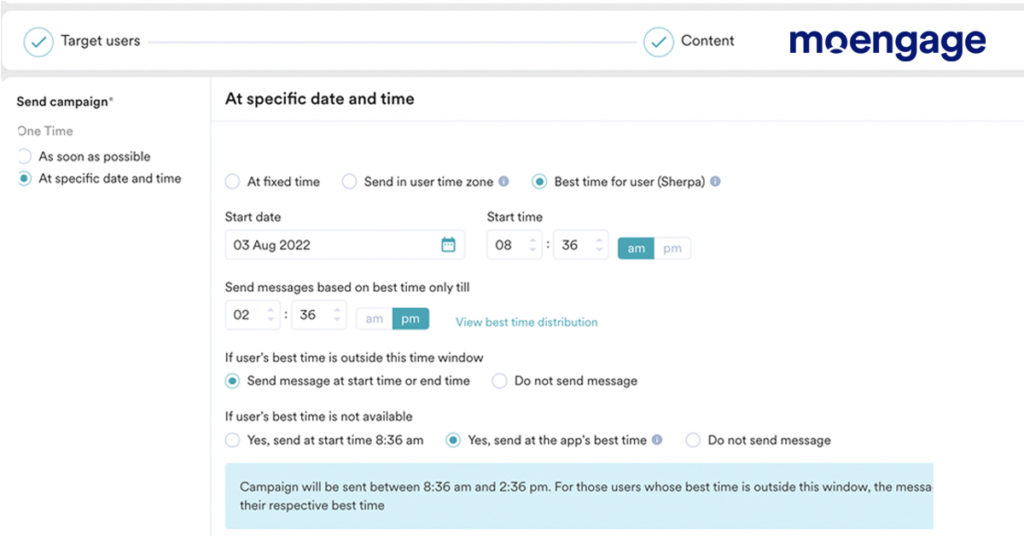
It chooses each customer’s optimal hour for receiving messages, based on the customer’s interaction with your messages over the past 60 days. This feature helps you send campaigns at a relevant time for each customer, when they’re most likely to engage.
D) Generative AI content for multiple channels
Einstein Generative AI can create preheaders, subject lines, and body copy for emails, and extend support to SMS content as well. It also integrates with Typeface to generate images. But for other channels like push and in-app messages, you need to create content manually.
MoEngage’s Merlin AI fills that gap.
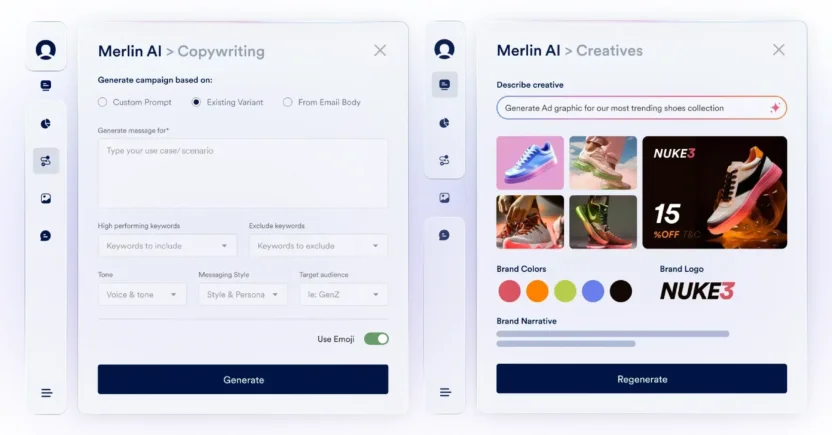
Merlin AI Copywriter is embedded inside the campaign creation flow for email, push, on-site, and in-app messages. Start by defining your target audience, campaign use case, and writing tone and style. You can add or exclude keywords based on historical campaign performance data, and personalize text with dynamic attributes.
Merlin AI Designer can also create images and banners for these channels, based on optional reference images and detailed text prompts. The good news is, you don’t need to leave MoEngage’s campaign builder for any of this. That means no switching tools, no separate integrations to produce AI-driven content across multiple touchpoints.
2. Best for mobile-ready email templates: Constant Contact
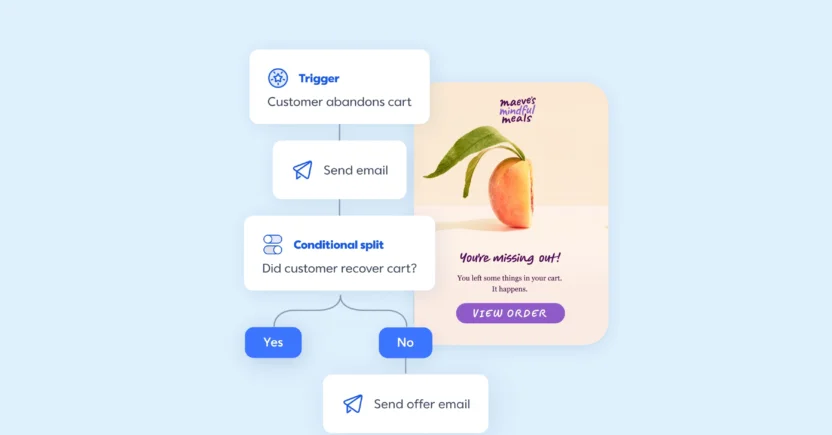
If you need a marketing platform that’s built for startups, Constant Contact is the best pick. It’s simple to set up, lets you reach audiences via email, social, and text, and works well when your focus is building a list or turning more clicks into sales.
However, its SMS tool has limitations, like blocking pre-approved contact lists. Its email automations also lack the depth and flexibility you need to create complex automated email workflows. And every so often, you’ll find parts of its user interface dragging when loading.
Cost: Pricing increases with the size of your contact list, with three tiers per band. For example, 30K-35K contacts cost between $340 and $485 every month. Anywhere between 45K and 50K contacts, and you’ll cough up $430-$575 per month. SMS marketing is always an extra charge.
G2 Rating: 4.1/5
Channels: Email, social media, and SMS (for US customers only)
Standout Feature: Text-to-join, a quick way for customers to subscribe to your email and SMS list via text message.
Why It’s Best for Mobile-Ready Email Templates: Constant Contact offers email templates that are a breeze to tweak and look great on smartphones.
3. Best for building content: SAP Emarsys
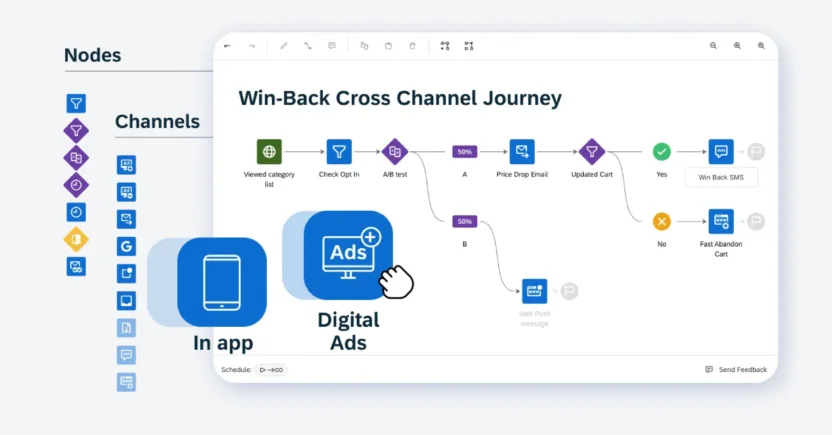
SAP Emarsys finds itself among the top Salesforce Marketing Cloud alternatives because of its intuitive automation workflows. The customer engagement handle of Intelligent CX from SAP, this platform is noted for its user-friendly segmentation tools.
However, many Emarsys users have flagged the platform’s unclear SDK documentation and lack of a smooth integration pipeline. Furthermore, its analytics reports aren’t straightforward enough for users to understand the channel-specific campaign performance. You need to separately investigate each channel’s performance, and then dive into the campaign performance as a whole. That’s a time-consuming process.
G2 Rating: 4.3/5
Channels: Email, SMS, in-app messages, digital ads, push notifications, website personalization, direct mail, mobile wallet, WhatsApp, and social media.
Standout Feature: Mobile wallet loyalty cards to encourage customers to redeem their rewards, online or offline.
Why It’s Best for Building Content: SAP Emarsys users have noted that the platform’s predefined content blocks in the drag-and-drop builder make it easy to build content for messages.
4. Best for sales and marketing alignment: HubSpot Marketing Hub
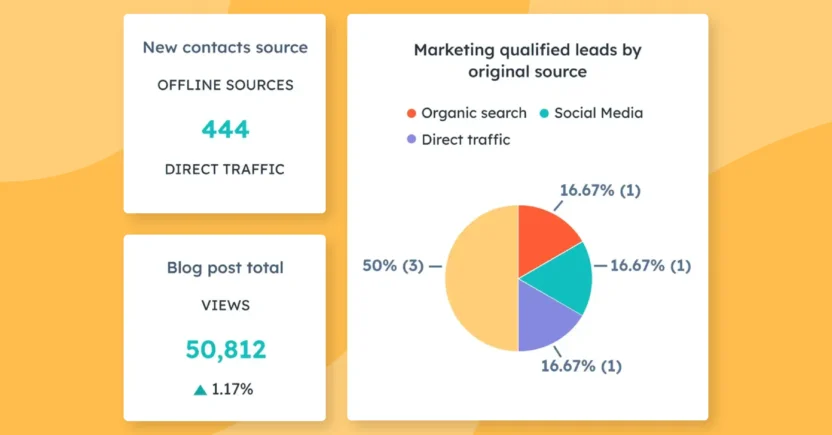
HubSpot Marketing Hub is a part of the larger HubSpot CRM platform. This means your marketing automation always pulls data from the same central pool of customer data that your sales team uses.
But combining multiple databases for different functions on one platform isn’t as smooth as it sounds. Before you know it, the sheer volume of cross-functional workflows and data can start feeling overwhelming. Smaller marketing teams have particularly called for better onboarding and clearer guidance, citing a steep learning curve for beginners.
Cost: Starts at $890/ month for 3 users, 5K campaigns, and 2K marketing contacts per account. Each additional user costs $50. Onboarding is a one-time $3K fee. The Enterprise plan jumps to $3,600/ month for 5 users and 10K marketing contacts, with an onboarding fee of $7K.
G2 Rating: 4.5/5
Channels: Email, SMS, and social media. You can integrate HubSpot with OneSignal for push notifications. WhatsApp integration is available as well.
Standout Feature: Lookalike Lists, which help you pinpoint and target prospects who resemble your best existing leads.
Why It’s Best for Sales and Marketing Alignment: As your marketing and sales data live in the same system, this connection makes it easier to prove ROI to your stakeholders.
5. Best for simple email marketing automation: Brevo
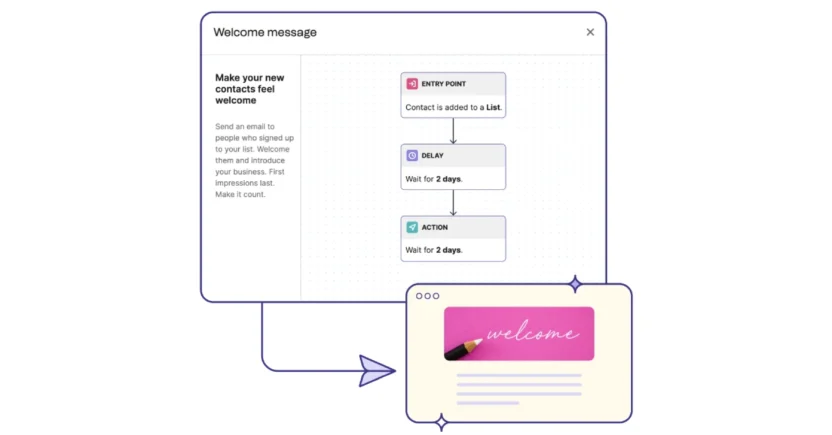
As one of the top Salesforce Marketing Cloud competitors, Brevo offers A/B testing, signup forms, landing pages, and even its own CRM for lead tracking and segmentation. You can score leads and share customer journey dashboards across marketing, sales and support teams to keep everyone on the same page.
There’s even more good news. Oakley Capital and General Atlantic have recently acquired Brevo. The point is that this $1B acquisition may enhance the platform’s marketing automation capabilities.
But there’s a reason why Brevo is a good choice for ‘simple’ email marketing automation. Once you try scaling into complex campaigns, limitations begin to surface. Its analytics and reporting lack the customizations and flexibility you’d need for omnichannel strategies. Plus, editing advanced forms or adjusting certain automated triggers isn’t always easy.
Cost: The Free plan allows 9K monthly emails and automation for up to 2K contacts, capped at 300 emails per day. Paid plans start at $9K/ month for 5K sends. Charges would be extra for push notifications, A/B testing, or a dedicated account manager.
G2 Rating: 4.5/5
Channels: Email, web push, SMS, and WhatsApp
Standout Feature: Heatmap reporting to identify the places where recipients click inside your emails
Why It’s Best for Simple Email Marketing Automation: The drag-and-drop email builder and pre-made automated journeys get highly favorable reviews from Brevo’s users.
Other Potential Salesforce Marketing Cloud Alternatives
Beyond the big alternatives to Salesforce Marketing Cloud that we’ve already compared, there are more names in the customer engagement space. A mixture of both legacy and modern platforms, they come with their own strengths and trade-offs. It’s worth taking a look at them:
1. Adobe Marketo Engage
Adobe Marketo Engage integrates well with CRMs, making it easier to pass sales-ready leads to your team.
But the catch is, Adobe is still a legacy platform, just like Salesforce Marketing Cloud. With any legacy tool, the story’s always the same — slower performance, a steep learning curve, and clunky interfaces. It doesn’t work if you want an agile campaign creation process and fast iterations. So you might want to take a look at the top alternatives to Adobe Marketing Cloud.
2. Oracle Responsys
With Oracle Responsys, you can easily run multilingual campaigns inside a single setup. That’s a bonus point for big global brands.
The downside? It covers only email, SMS, and push notifications. No RCS, no WhatsApp. And as with other legacy systems, like Salesforce Marketing Cloud Engagement, building out multiple email campaigns can feel sluggish.
Channel gaps and slow go-live times are tough obstacles when your customers expect a fast and smooth buying experience. If you want to make a better choice, pick one of the top Oracle Responsys alternatives.
3. Iterable
Iterable earns points for advanced segmentation. With integrations to 109 apps, it’s flexible enough to fit into most martech stacks.
But it stumbles when it comes to analytics and reporting. Unless you bolt on a separate data warehouse or external BI tools, detailed reports are out of the question. When building heavier automation workflows, Iterable users have also flagged slow performance as a major pain point.
So you’re free to explore the best Iterable alternatives, too, just in case.
4. Braze
Even though it’s not a legacy system, Braze’s real-time data platform and journey orchestration make it one of the potential Salesforce Marketing Cloud competitors. Its drag-and-drop journey builder is easy to navigate without HTML skills.
The drawback is that integrations can be more complex than expected. The initial setup is often daunting as well, until you’ve gained the necessary technical know-how. But don’t be dismayed, you can always sift through the best Braze alternatives.
6 Key Criteria to Consider When Evaluating Agentforce Marketing Competitors
Evaluating the top Agentforce Marketing competitors means choosing a customer engagement platform that caters to your needs today and tomorrow. Basically, it should keep pace with your brand’s growth, and adapt quickly when your market changes.
Keeping that in mind, let’s look at the six factors you should take into account when considering alternatives to Salesforce Marketing Cloud.
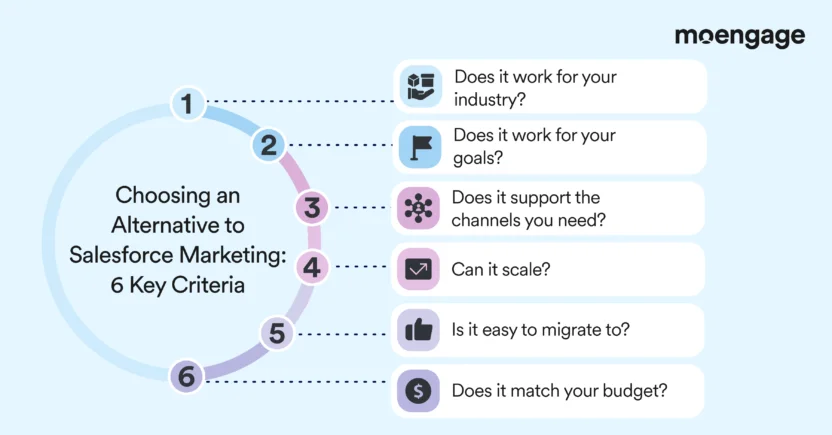
1. Whether it works for your industry
Different industries have different demands. For example, retail brands want advanced customer loyalty program logic. Travel companies need automated subscription renewals syncing with their booking data.
But with Salesforce Marketing Cloud, implementing niche requirements can be frustrating, especially with its legacy architecture and generic workflows. Therefore, regardless of which Agentforce Marketing alternatives you shortlist, ensure they offer features tailored to your specific industry.
Questions to ask yourself about this when looking for a Salesforce Marketing Cloud alternative:
- Does the Salesforce Marketing Cloud competitor offer pre-built templates or workflows for your industry?
- Does it adhere to industry-specific standards and regulations, such as the Health Insurance Portability and Accountability Act (HIPAA) for healthcare or the Payment Card Industry Data Security Standard (PCI DSS) for fintech?
- Are its analytics and reporting tailored to monitor and analyze niche metrics?
- Have they worked with brands in your niche before? How successful have those collaborations been?
2. Whether it works for your goals
A customer engagement platform can have numerous advanced features. But at the end of the day, the features must be useful for achieving your actual goals.
Salesforce Marketing Cloud, for instance, can technically run almost anything. Nonetheless, its users struggle because they need to switch between Salesforce’s various offerings for even basic objectives, such as reducing churn or improving repeat purchase rates. Apart from the obvious confusion that follows, it slows you down when time-to-market matters.
If your goal is to recover abandoned carts or grow customer Lifetime Value (LTV), you need behavior-based segmentation, AI-driven personalization, and RFM analysis, all in one place. Not scattered across different marketing offerings, like Salesforce Marketing Cloud Advanced or Salesforce Marketing Cloud Engagement.
Questions to ask yourself about this when looking for a Salesforce Marketing Cloud alternative:
- What short-term goals do you want to achieve (e.g., higher email open rates)?
- What long-term goals do you want to achieve (e.g., improving customer loyalty)?
- Does the Agentforce Marketing alternative align with both these goals?
- Will it support AI-driven recommendations and testing inside workflows?
- Does it let you run A/B and multivariate tests across customer journeys?
- Can it deliver predictive analytics and personalization deeper than Salesforce’s current capabilities?
3. Whether it supports the channels you need
Salesforce Marketing Cloud supports core channels like email, SMS, mobile push notifications, social media, WhatsApp, and ads. But it’s inherently an email-first platform. Certain rich formats or engagement channels may not be as functional as you might expect.
All the more reason to map out which channels you need to reach your customers, and why. Because if there’s no coherent omnichannel customer experience with your brand, you lose engagement.
For example, let’s say you’ve just bought a new customer engagement platform and can’t wait to send out web push notifications, only to find that it can send out push notifications just on mobile.
Questions to ask yourself about this when looking for a Salesforce Marketing Cloud alternative:
- Can the new platform send campaigns through your required channels?
- Does it deliver true omnichannel customer journey orchestration in one dashboard?
- Can it send messages at a customer’s optimal time or on their most preferred channel?
- Does it come with channel performance dashboards?
- Does it follow compliance standards for all channels in your mix?
4. Whether the Salesforce Marketing Cloud competitor can scale
The Agentforce Marketing alternative you choose should be able to grow with your brand. Expanding your customer base across new regions and taking on new channels should feel seamless. If growing your brand means slower workflows on the new platform, then it’s not a good fit for your team.
Questions to ask yourself about this when looking for a Salesforce Marketing Cloud alternative:
- How well does the platform handle large datasets without lagging?
- Can it expand to new engagement channels as your needs evolve?
- Does it integrate smoothly with new tools as your martech stack evolves?
- Does it have built-in multilingual support and localization?
- Can the support team manage larger, more complex brands?
5. Whether it’s easy to migrate to
With Salesforce Marketing Cloud’s sprawling marketing offerings, migrating data and campaigns to a new platform can feel like shifting to a new house with thousands of tiny boxes.
Salesforce’s onboarding for new users can also take months, as its modules require manual configuration to work together. So, the Salesforce Marketing Cloud alternative should enable seamless movement of workflows, assets, and contact lists, allowing for quick transitions without downtime.
Questions to ask yourself about this when looking for a Salesforce Marketing Cloud alternative:
- How fast can your marketing team start sending campaigns after migration?
- Will the vendor handle data transfers and setup directly?
- Will all the promised features be ready before launch?
- How complex are the API integrations with your current stack?
- Does the vendor provide comprehensive training, documentation, and other migration support to help onboard your team quickly and efficiently?
- Is there a dedicated migration or onboarding manager to guide the process?
6. Whether it matches your budget
Apart from licenses, Salesforce Marketing Cloud’s pricing depends on whether you have to rope in agencies or developers to maintain and optimize your campaigns. That adds to the Total Cost of Ownership (TCO) fast.
As long as the ROI comes in faster than your expenses, a high TCO is acceptable. But what if the Salesforce Marketing Cloud alternative can cover more features and capabilities in one place, with less maintenance work? In that case, you may see a stronger ROI for the same or a lower investment.
Questions to ask yourself about this when looking for a Salesforce Marketing Cloud alternative:
- How does the upfront cost of the Agentforce Marketing alternative compare to that of Salesforce?
- Are integrations, customizations, or support included in the pricing?
- Will you have to hire agencies for onboarding or implementing your campaigns? If so, would the additional fees fit your budget?
- Are any channels or features treated as add-ons?
- Are there any hidden fees?
- How fast can you realistically expect ROI based on the platform’s capabilities?
Top 3 Salesforce Marketing Cloud Alternatives: Feature Comparison
As you can understand, the right customer engagement platform is the one that fits your industry, goals, channel requirements, scale, and budget. Weighing all these factors, we’ve zeroed in on the top three Salesforce Marketing Cloud competitors — MoEngage, Constant Contact, and SAP Emarsys.

Next, let’s see how they stack up against each other in terms of the major features that are useful for B2C marketers today.
| Criteria | Salesforce Marketing Cloud (now Agentforce Marketing) | MoEngage | Constant Contact | SAP Emarsys |
| G2 Rating | 4.0/5 | 4.5/5 | 4.1/5 | 4.3/5 |
| Channels Supported | Email-first. Supports SMS, mobile push, WhatsApp & social ads. | Mobile & web push notifications, email, WhatsApp, SMS, RCS, web personalization, in-app messaging, on-site messaging, Facebook Audience & Google Ads Audience. | Email, social & SMS (U.S. only). | Email, SMS, in-app messages, digital ads, push notifications, website personalization, direct mail, mobile wallet, WhatsApp & social media. |
| Send Time Optimization | For email & push | For email, push & SMS | Not available | For email only |
| Most Preferred Channel | Not available | Identifies the channel each customer is most likely to engage with | Not available | Not available |
| AI Content Creation | For emails & SMS | For emails, push, in-app & on-site messages | For emails, landing pages, SMS & social captions | For emails only |
| AI Image Generation | Through Typeface integration | Through built-in Merlin AI Designer | Not available | Not available |
5 Migration Strategies When Switching to a Salesforce Marketing Cloud Competitor
Let’s say you’ve already chosen one of the top Agentforce Marketing competitors. No matter how fast or how advanced your new customer engagement platform is, long-drawn migration timelines are always a bummer.
To ensure it doesn’t come to that, here are some customer engagement platform migration strategies you can follow for a hassle-free migration to the platform.
1. Map out a migration plan with deadlines
Before exporting data, put together a detailed roadmap. It should include step-by-step, phased actions that everyone on your team and the vendor’s team will take to complete the migration.
Break out each step into the components it needs:
- What historical events do you need to import?
- Will you use integrations or CSV uploads?
- How much time will each team take to complete their respective tasks?
Don’t forget to set realistic timelines. Once you’ve mapped it out, run it by your vendor to ensure that both teams are on the same page. Assigning someone to track the plan is also a good idea.
2. Build a migration team
Include any team involved in your campaigns or data flows, such as your product, IT, and marketing teams. With their inputs, you can set up your new platform in a way that follows compliance rules and naming conventions.
Loop stakeholders in early, so their insights can shape the setup. This ensures that your team doesn’t flounder after getting feedback from stakeholders just two days before launch. You can also set up weekly check-ins to keep the timelines aligned between your team and the vendor’s.
MoEngage, for example, has certified project managers to handle the migration services and ensure every team’s needs are taken care of. This helped MoEngage migrate 200+ SoundCloud campaigns in 12 weeks. The result? SoundCloud’s engagement rose by 15% in music streams.
3. Document the migration process
Let’s face it: you might have to replicate the migration process in the future. Especially if you update your brand image or, more obviously, migrate to a different platform for any reason.
Write down everything you can about the process. Include data pipelines, workflow rules, naming conventions, data mapping choices, and any module-specific settings.
Check with your vendor, too, to see if they have any resources available, such as troubleshooting guides and API documentation.
4. Test and troubleshoot during migration
Not everything works perfectly on the first try. Your timeline should definitely set aside some time for testing and fixes.
Whenever each workflow is live in the Salesforce Marketing Cloud alternative, run tests on it. Are your cross-channel campaigns connecting properly? Is the data flowing exactly as you expected it to?
Pull in members from each of your marketing, IT, and product teams to test the platform and confirm if everything works. Don’t wait until just a few days before launch for testing.
5. Leverage post-migration onboarding
Your team needs to be able to work confidently within the new platform. Plan vendor-led training sessions. On the calls, review campaign goals, reporting requirements, and feature usage together.
Schedule regular check-ins with your vendor, where they can answer your questions and help you troubleshoot issues before they escalate.
Early investment in onboarding always pays off. The faster your team gets comfortable with the new platform, the faster you’ll see results for your campaigns.
Take the example of MoEngage. With consistent post-migration support, our Professional Services team scheduled weekly catch-ups with Click Rain, a South Dakota digital agency, after they migrated to MoEngage. Through these catch-ups, the entire team became comfortable using the platform to its full potential. That’s how Click Rain’s migration to MoEngage saved over $18K for their client.
Top 4 FAQs Answered About Agentforce Marketing Alternatives
Here are some common questions B2C marketers typically ask while evaluating alternatives to Agentforce Marketing.
1. What are the main reasons B2C lifecycle marketers look for a Salesforce Marketing Cloud competitor?
For a lot of marketing teams, Salesforce Marketing Cloud means dealing with a split product setup, steep learning curves, and long rollout timelines. Even though the platform in itself is powerful, it’s resource-heavy and slow to adapt to your evolving needs. Customer support is also below par, as is expected with legacy systems.
Modern customer engagement platforms like MoEngage pack in truly omnichannel reach, built-in AI, advanced marketing automation, and faster onboarding in one place. And it all comes without the roadblocks you’d normally run into on legacy systems like Salesforce Marketing Cloud.
2. How does customer engagement software like Salesforce Marketing Cloud or Agentforce Marketing work?
Salesforce Marketing Cloud or Agentforce Marketing is part of Salesforce’s larger suite of marketing and CRM tools. It’s designed to help you automate and manage campaigns across channels, and analyze performance.
Within this platform, Marketing Cloud Engagement handles content creation, campaign execution, and send-time optimization. On the other hand, Marketing Cloud Next focuses on customer data management and audience segmentation.
You’re essentially working across separate environments for different parts of the same customer engagement puzzle.
3. What are the biggest factors that affect the price of alternatives to Salesforce Marketing Cloud software?
The cost of a modern Salesforce Marketing Cloud alternative usually depends on the following factors:
- Audience size: Many vendors, including MoEngage, price based on Monthly Tracked Users (MTUs) or the total number of engaged contacts.
- Features: AI-driven personalization, predictive analytics, and data security features like PII Tokenized Sending often sit in higher pricing tiers.
- Number of channels: The more channels you include, the higher your vendor’s invoice. Even more so, if they charge for some channels as add-ons.
4. How should you price, compare, and shop for an Agentforce Marketing alternative option effectively?
Start with a document of what you need. List the automation and AI capabilities your campaigns must have. Mention the channels you run today, and the ones you plan to add.
Next, compare Salesforce Marketing Cloud alternatives in terms of pricing and their migration timelines for brands like yours.
Finally, watch a demo or test the new platform yourself in a sandbox environment. You can easily experience if the platform is intuitive enough for your team to pick up on quickly.
Take Your Pick From the Best Salesforce Marketing Cloud Competitors
No lie, switching customer engagement platforms can feel like a mammoth step, especially if you’ve been deep in the Salesforce Marketing Cloud ecosystem for a long time. In such a scenario, narrowing down your choices from among the top Agentforce Marketing or Salesforce Marketing Cloud competitors and alternatives becomes easy only when you ask the right questions.
MoEngage, for example, is built to launch campaigns in mere minutes. With AI-powered send-time optimization and Most Preferred Channel, advanced segmentation like RFM analysis, plus built-in multichannel AI content creation, MoEngage gives you what Salesforce leaves out or splits across offerings.
So, the right question here is, do you need these advanced features? Do you need the channels this platform offers, including web push, RCS, and on-site messaging?
Nodded your head? Let’s move on to the next question, the most important of all. Want to see how MoEngage can drive engagement for your brand? Simply book a demo to gaze at how seamless truly omnichannel engagement can be.

